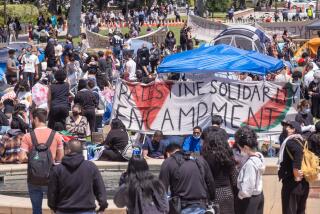Civil Rights Fables : AND WE ARE NOT SAVED The Elusive Quest for Racial Justice<i> by Derrick Bell(Basic Books: $19.95; 274 pp.)</i>
- Share via
Do we need yet another book on Civil Rights in the United States?
But this is not just another civil rights book. Consider “Divining a Nation’s Salvation,” the third of its three parts. In this part, in the midst of a hypothetical convention of concerned black people from all over the country, a cure for the rampaging crime wave in their midst is suddenly discovered:
“And then the Black Crime Cure was discovered. Deep in a cave used to hide illegal narcotics, a black gang from a big-city ghetto found a stream whose bed was covered with small ruby-red stones about the size of peas. It is not clear how the gangleader came to swallow one of the small stones, perhaps by accident, but the effect was immediate and acute.
“The converted drug dealer himself not only immediately lost all inclination to wrongdoing but was possessed with an overpowering desire to fight black crime wherever it existed. Somehow associating his changed outlook with the stone, he managed to feed one to each of his band. Instantly they, too, were changed from criminals to crime fighters. After considering how they might further their crusade, they dumped all their narcotics and filled the containers with what they were already calling the ‘crime cure stones.’
“Time does not permit a full recounting of how the Black Crime Cure was distributed across the country. While the stones seemed to give indigestion to whites who took them, they worked as they had in the cave for anyone with a substantial degree of African blood. Black people were overjoyed and looked forward to life without fear of attack in even the poorest neighborhoods. Whites also lost their fear of muggings, burglary, and rape.”
The man on the street can read the fable that structures this book and learn lessons with profit and enjoyment. On the other hand, the scholar can read the author’s instructive footnotes and know that he or she is reading not a novel but a well-documented study that crosses the spectrum of Black history, literature, politics and women’s studies.
A Harvard professor of law, Derrick Bell is no newcomer either to civil rights issues whether on the streets or before the Supreme Court. He has written an unusual book using a didactic fable to detail a very serious American dilemma.
In Part One of the book, “The Legal Hurdles to Racial Justice,” Geneva Crenshaw, a fictitious civil rights attorney, chronicles her experiences in the South, particularly in Mississippi, as the difficult social experiment of the ‘60s--ending segregation and substituting integration or desegregation--gives way to the reactionary years of the late ‘70s and early ‘80s. For each chapter, there is a separate fable, all of them from the mouth of Geneva Crenshaw. They deal with the contradiction in the U.S. Constitution, the injustice of the American judicial system, the limitations in black voting rights, the reduction of blacks to guinea pigs in our school system, the long uneven battle against segregation, the fight for and against affirmative action and the cloud of unreality over the equal protection laws.
Part Two, “The Social Affliction of Racism,” deals with psychological phenomena. Here we are concerned wtih the effects of the psychic wounds of racism on the minds of all the people. Directly, Bell only examines the human relationships of black families and the wounds of black minds. But indirectly, these psychic phenomena are common to all Americans.
I like the use of the character Geneva as a didactic persona. In her mouth Bell has placed many suggested solutions as well as a realistic portrayal of the problems inherent in our national and institutionalized racism:
“Despite your optimism, you seem ready to agree that the future for a great many black people is bleak. The necessary question that I hope we can decide during our discussions is whether this result--this economic-political disadvantage set in motion by the Framers (of the Constitution)--is beyond any known power to halt or even alter. Or, whether different strategies might make the annual observances of the Brown decision celebrations of great expectations realized rather than increasingly sorrowful commemorations of what might have been. And finally, whether, as I tried to suggest to the Framers, the real problem of race in America is the unresolved contradiction embedded in the Constitution and never openly examined, owing to the self-interested attachment of some citizens of this nation to certain myths--myths that I hope my Chronicles will allow us to examine in detail.”
The intriguing title of this book “And We Are Not Saved” has both religious and social meaning. Jeramiah, the Old Testament prophet, was a prophet both of doom and of Deuteronomic reform. He predicted the fall of Jerusalem and the Babylonian Captivity of the Jews, but he also preached the “Second Law” of Deuteronomy, the reform which King Josiah instituted.
“The harvest is past, the Summer is ended, and we are not saved.”
This physical harvest is an analogy. After all the civil rights struggle of the 1960s, all the martyred dead and assassinated, all the legislation passed by Congress, the street fighting and rioting, demonstrations, dozens of books and speeches, still “We Are Not Saved.”
In a critical year celebrating 200 years of our Constitution the question still remains: Must we lose our present form of constitutional government before we can end racism in our society? Must there be a “Second Law”?
“The harvest is past, the Summer is ended, and we are not saved.”
More to Read
Sign up for our Book Club newsletter
Get the latest news, events and more from the Los Angeles Times Book Club, and help us get L.A. reading and talking.
You may occasionally receive promotional content from the Los Angeles Times.









